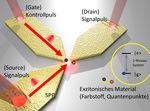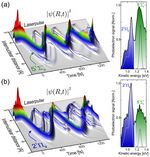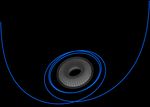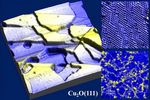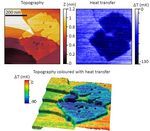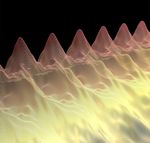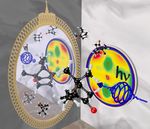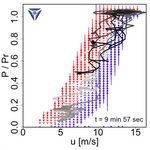Pictures and Videos
Pictures and Videos
Pictures and videos from the research
Latest entries at the top.
Working principle of a new, remotely-driven source of ultrashort electron pulses. Near-infrared laser pulses illuminate a grating coupler on the shaft of an atomically sharp gold taper. The light is coupled to a surface plasmon polariton on the taper, which is nanofocused to the apex due to the reducing wire diameter. At the apex, the electric field strength becomes so strong that electron are emitted. With this method, short electron pulses can be generated while avoiding direct illumination of the emission site.
For details see doi.org/10.1021/acs.nanolett.5b01513
Group: Ultrafast Nano-Optics
Schematic description of the all-photonic transistor: Ultrashort, few-femtosecond laser pulses are coupled from the far field to a few-nanometer-sized volume using plasmonic nanostructures. Only if the gap between the left (source) and the right (drain) plasmonic nanoantenna is a few nanometer or less, light can be effectively transferred from one nanostructure to the other and a signal is transferred. This transmission can now be manipulated on a femtosecond time scale by placing single dye molecules in this gap and by manipulating its electronic state by a gating ultrashort laser pulse.
Group: Ultrafast Nano-Optics
Measurements with High-Speed Stereo Particle Image Velocimetry (PIV) and two-dimensional Laser Doppler Anemometry (LDA) on the flow around an airfoil. Atmospheric turbulence in the wind tunnel is generated with an Active Grid. Force, torque and pressure sensors measure the dynamic forces acting on the airfoil.
Molecular wavepacket dynamics of potassium molecules excited efficiently to (a) the upper and (b) the lower target state using specifically tailored femtosecond laser pulses (shown in the back). The right-hand side displays measured (solid line) and simulated (dashed lines) photoelectron spectra, indicating ultrafast efficient switching of the photoinduced electron-nuclear dynamics among both molecular target states.
For details see: Phys. Rev. Lett. 110, 123003 (2013), J. Phys. B 47, 124015 (2013)
Group: Ultrafast Coherent Dynamics
In a higher dimensional world described by the string theory, the event horizon of a black hole is not necessarily a sphere. A black hole with a torus-shaped horizon is called a black ring. The picture shows the trajectory of a particle orbiting such a black ring. Orbits of test particles can be used to calculate observables, which can later be compared to observations to test different theories.
For details see Phys. Rev. D 87, 044054 (2013) and Phys. Rev. D 86, 104002 (2012)
Group: Field Theory
Thin films of cuprous oxide have been grown on an Au(111) single crystal and characterized by scanning tunneling microscopy and optical spectroscopy. The images on the left and upper right display the overall film morphology (200 × 200 nm2) and its atomic structure (15 × 15 nm2), while the panel on the lower right shows a conductance map. The electron transport is strongly enhanced along dislocation lines in the oxide lattice (yellow lines).
Group: Scanning Probe Spectroscopy
Visualization of the bistability of a near-field thermal memory based on vanadium dioxide. The near-field thermal transistor, diode and memory proposed by us are nanoscale devices with the same functionality as their electronic counterparts, but instead controlling electric currents they enable one to control and amplify heat currents carried by thermal photons.
For details see:
Diode: Appl. Phys. Lett. 103, 191907 (2013)
Transistor: Phys. Rev. Lett. 112, 044301 (2014)
Memory: Phys. Rev. Lett. 113, 074301 (2014)
Group: Condensed Matter Theory
In metallic nanostructures electric fields can be confined to few-nanometer distances, much smaller than the diffraction limit of light. By using He-ion beam lithography gold nanoantennas with unprecedented precision were fabricated in which the squeezed electric field was enhanced by more than two orders of magnitude.
For details see Nano Lett. 2014, 14, 4778−4784
Group: Ultrafast Nano-Optics
Experiments on the influence of thin films on the near-field mediated heat transfer by near-field scanning thermal microscopy discovered a distinct enhancement in heat transfer above NaCl islands compared to the bare Au(111) film, at the fundamental limit of single monolayer islands.
For details see Phys. Rev. Lett. 110, 134302 (2013)
Group: Energy and Semiconductor Research
Transmission coefficient of nanoscale radiative heat transfer between two hyperbolic multilayer metamaterials. The dominant heat transport channels are given by the contribution of narrowband surface modes and broadband hyperbolic modes.
For details see Appl. Phys. Lett. 102, 131106 (2013) and Phys. Rev. Lett. 109, 104301 (2012)
Group: Condensed Matter Theory
Two atoms in close vicinity to a sheet of graphene. The energy transfer between both atoms is mediated by the plasmons inside the graphene layer. This enhances the energy transfer significantly at distances corresponding to the propagation length of the graphene plasmons as shown in the inset.
For details see Appl. Phys. Lett. 103, 243112 (2013)
Group: Condensed Matter Theory
Sharp metallic nanotapers irradiated with few-cycle laser pulses are emerging as a source of highly confined coherent electron wave packets with attosecond duration and strong directivity. The picture shows the energy distribution of emitted electrons.
For details see Nature Photonics 8, 37-42 (2014)
Group: Ultrafast Nano-Optics
Mirror, mirror. The ionization of chiral molecules with circularly polarized light creates an enhancement of the photoelectron angular distribution in the forward direction relative to the laser beam. The mirror-image distribution is obtained with the mirror-image enantiomer. The effect allows enantiomers to be distinguished in the gas phase.
For details see Angewandte Chemie 51.20 (2012) 5001-5005
Group: Ultrafast Coherent Dynamics
The Sphere Anemometer (blue) is a robust wind speed and direction sensor based on highly resolving laser metrology. The anemometer for applications in wind energy and meteorology is developed in Oldenburg and was installed for field test at two near-shore sites in the German Wadden Sea (Foto: Installation on wind turbine near Hooksiel).
Dynamics of a modern wind turbine's electrical power output on a one-second scale. The background shows the deterministic drift field of a reconstructed Langevin equation for the power conversion dynamics.
For details see Phys. Rev. Lett. 110, 138701 (2013)
Small-scale intermittency in developed turbulence is intimately related to negative entropy production along the eddy-hierarchy. The rapid convergence of the exponential average shown in the plot is due to the substantial fraction of entropy-consuming trajectories in the shaded region of the inset.
For details see Phys. Rev. Lett 110, 214501 (2013)
Group: Statistical Physics


